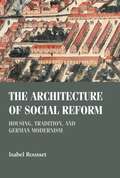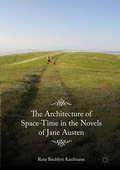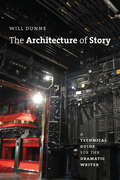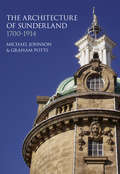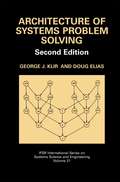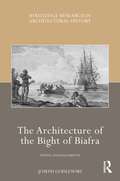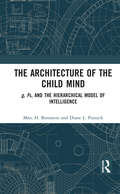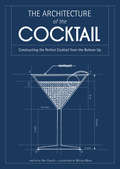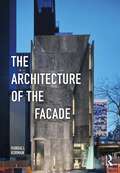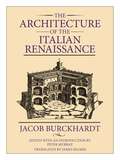- Table View
- List View
The architecture of social reform: Housing, tradition, and German Modernism (Studies in Design and Material Culture)
by Isabel RoussetThe architecture of social reform explores the fascinating intellectual origins of modern architecture’s obsession with domesticity. Copiously illustrated, Rousset’s revealing analysis demonstrates how questions over aesthetics, style, urbanization, and technology that gripped the modernist imagination were deeply ingrained in a larger concern to reform society through housing. The increasing demand for new housing in Germany’s rapidly growing cities fostered critical exchanges between a heterogeneous group of actors, including architects, urban theorists, planners, and social scientists, who called for society to be freed from class antagonism through the provision of good, modest, traditionally-minded domestic design. Offering a compelling account of architecture’s ability to act socially, the book provocatively argues that architectural theory underwent its most critical epistemological transformation in relation to the dynamics of modern class politics long before the arrival of the avant-garde.
The architecture of social reform: Housing, tradition, and German Modernism (Studies in Design and Material Culture)
by Isabel RoussetThe architecture of social reform explores the fascinating intellectual origins of modern architecture’s obsession with domesticity. Copiously illustrated, Rousset’s revealing analysis demonstrates how questions over aesthetics, style, urbanization, and technology that gripped the modernist imagination were deeply ingrained in a larger concern to reform society through housing. The increasing demand for new housing in Germany’s rapidly growing cities fostered critical exchanges between a heterogeneous group of actors, including architects, urban theorists, planners, and social scientists, who called for society to be freed from class antagonism through the provision of good, modest, traditionally-minded domestic design. Offering a compelling account of architecture’s ability to act socially, the book provocatively argues that architectural theory underwent its most critical epistemological transformation in relation to the dynamics of modern class politics long before the arrival of the avant-garde.
The Architecture of Space-Time in the Novels of Jane Austen
by Ruta Baublyté KaufmannThis book argues that there are recurrent spatiotemporal patterns and structures in six Jane Austen novels which constitute a source of enduring, if unconscious, pleasure. More precisely, the book contends that there are overlapping natural and cultural cycles which co-exist in a constantly transmuting space-time and which are counterpointed with the linearity of pivotal events that drive the plot forwards. This work examines the psychological relations to these space-time patterns of the characters, principally the heroines, focusing on the transformations of their emotional states which prompt linear leaps.
The Architecture of Space-Time in the Novels of Jane Austen
by Ruta Baublyté KaufmannThis book argues that there are recurrent spatiotemporal patterns and structures in six Jane Austen novels which constitute a source of enduring, if unconscious, pleasure. More precisely, the book contends that there are overlapping natural and cultural cycles which co-exist in a constantly transmuting space-time and which are counterpointed with the linearity of pivotal events that drive the plot forwards. This work examines the psychological relations to these space-time patterns of the characters, principally the heroines, focusing on the transformations of their emotional states which prompt linear leaps.
The Architecture of Steam: Waterworks and the Victorian Sanitary Crisis
by James DouetSteam pumping stations are exceptional buildings, a rousing, eloquent architecture designed by engineers, and an industrial edifice intended to express civic pride. They were invented, perfected and superseded in barely a century during the determined struggle to overcome the historic threat to urban life posed by industrialization. Of the buildings of the industrial period only train stations can compete with waterworks for stylistic bravura, carried over into the cool, tiled interiors and the sparkle and warmth of the cherished steam engine. This first comprehensive account of a remarkable fusion of machinery and structure weaves together architectural fashions, shifting social conditions and engineering inventiveness to show why such care was taken by the communities that commissioned them and by the men who built them, and what makes us take such pleasure in them today. British waterworks heritage is a global reference, for the historical significance of the sites themselves but also for the conservation of the many preserved waterworks, often extending to the reanimation of historic steam engines. No prior knowledge of architecture, sanitation or steam technology is required to enjoy this spirited and richly-illustrated account of a singular British building.
The Architecture of Story: A Technical Guide for the Dramatic Writer (Chicago Guides to Writing, Editing, and Publishing)
by Will DunneWhile successful plays tend to share certain storytelling elements, there is no single blueprint for how a play should be constructed. Instead, seasoned playwrights know how to select the right elements for their needs and organize them in a structure that best supports their particular story. Through his workshops and book The Dramatic Writer’s Companion, Will Dunne has helped thousands of writers develop successful scripts. Now, in The Architecture of Story, he helps writers master the building blocks of dramatic storytelling by analyzing a trio of award-winning contemporary American plays: Doubt: A Parable by John Patrick Shanley, Topdog/Underdog by Suzan-Lori Parks, and The Clean House by Sarah Ruhl. Dismantling the stories and examining key components from a technical perspective enables writers to approach their own work with an informed understanding of dramatic architecture. Each self-contained chapter focuses on one storytelling component, ranging from “Title” and “Main Event” to “Emotional Environment” and “Crisis Decision.” Dunne explores each component in detail, demonstrating how it has been successfully handled in each play and comparing and contrasting techniques. The chapters conclude with questions to help writers evaluate and improve their own scripts. The result is a nonlinear reference guide that lets writers work at their own pace and choose the topics that interest them as they develop new scripts. This flexible, interactive structure is designed to meet the needs of writers at all stages of writing and at all levels of experience.
The Architecture of Story: A Technical Guide for the Dramatic Writer (Chicago Guides to Writing, Editing, and Publishing)
by Will DunneWhile successful plays tend to share certain storytelling elements, there is no single blueprint for how a play should be constructed. Instead, seasoned playwrights know how to select the right elements for their needs and organize them in a structure that best supports their particular story. Through his workshops and book The Dramatic Writer’s Companion, Will Dunne has helped thousands of writers develop successful scripts. Now, in The Architecture of Story, he helps writers master the building blocks of dramatic storytelling by analyzing a trio of award-winning contemporary American plays: Doubt: A Parable by John Patrick Shanley, Topdog/Underdog by Suzan-Lori Parks, and The Clean House by Sarah Ruhl. Dismantling the stories and examining key components from a technical perspective enables writers to approach their own work with an informed understanding of dramatic architecture. Each self-contained chapter focuses on one storytelling component, ranging from “Title” and “Main Event” to “Emotional Environment” and “Crisis Decision.” Dunne explores each component in detail, demonstrating how it has been successfully handled in each play and comparing and contrasting techniques. The chapters conclude with questions to help writers evaluate and improve their own scripts. The result is a nonlinear reference guide that lets writers work at their own pace and choose the topics that interest them as they develop new scripts. This flexible, interactive structure is designed to meet the needs of writers at all stages of writing and at all levels of experience.
The Architecture of Story: A Technical Guide for the Dramatic Writer (Chicago Guides to Writing, Editing, and Publishing)
by Will DunneWhile successful plays tend to share certain storytelling elements, there is no single blueprint for how a play should be constructed. Instead, seasoned playwrights know how to select the right elements for their needs and organize them in a structure that best supports their particular story. Through his workshops and book The Dramatic Writer’s Companion, Will Dunne has helped thousands of writers develop successful scripts. Now, in The Architecture of Story, he helps writers master the building blocks of dramatic storytelling by analyzing a trio of award-winning contemporary American plays: Doubt: A Parable by John Patrick Shanley, Topdog/Underdog by Suzan-Lori Parks, and The Clean House by Sarah Ruhl. Dismantling the stories and examining key components from a technical perspective enables writers to approach their own work with an informed understanding of dramatic architecture. Each self-contained chapter focuses on one storytelling component, ranging from “Title” and “Main Event” to “Emotional Environment” and “Crisis Decision.” Dunne explores each component in detail, demonstrating how it has been successfully handled in each play and comparing and contrasting techniques. The chapters conclude with questions to help writers evaluate and improve their own scripts. The result is a nonlinear reference guide that lets writers work at their own pace and choose the topics that interest them as they develop new scripts. This flexible, interactive structure is designed to meet the needs of writers at all stages of writing and at all levels of experience.
The Architecture of Story: A Technical Guide for the Dramatic Writer (Chicago Guides to Writing, Editing, and Publishing)
by Will DunneWhile successful plays tend to share certain storytelling elements, there is no single blueprint for how a play should be constructed. Instead, seasoned playwrights know how to select the right elements for their needs and organize them in a structure that best supports their particular story. Through his workshops and book The Dramatic Writer’s Companion, Will Dunne has helped thousands of writers develop successful scripts. Now, in The Architecture of Story, he helps writers master the building blocks of dramatic storytelling by analyzing a trio of award-winning contemporary American plays: Doubt: A Parable by John Patrick Shanley, Topdog/Underdog by Suzan-Lori Parks, and The Clean House by Sarah Ruhl. Dismantling the stories and examining key components from a technical perspective enables writers to approach their own work with an informed understanding of dramatic architecture. Each self-contained chapter focuses on one storytelling component, ranging from “Title” and “Main Event” to “Emotional Environment” and “Crisis Decision.” Dunne explores each component in detail, demonstrating how it has been successfully handled in each play and comparing and contrasting techniques. The chapters conclude with questions to help writers evaluate and improve their own scripts. The result is a nonlinear reference guide that lets writers work at their own pace and choose the topics that interest them as they develop new scripts. This flexible, interactive structure is designed to meet the needs of writers at all stages of writing and at all levels of experience.
The Architecture of Story: A Technical Guide for the Dramatic Writer (Chicago Guides to Writing, Editing, and Publishing)
by Will DunneWhile successful plays tend to share certain storytelling elements, there is no single blueprint for how a play should be constructed. Instead, seasoned playwrights know how to select the right elements for their needs and organize them in a structure that best supports their particular story. Through his workshops and book The Dramatic Writer’s Companion, Will Dunne has helped thousands of writers develop successful scripts. Now, in The Architecture of Story, he helps writers master the building blocks of dramatic storytelling by analyzing a trio of award-winning contemporary American plays: Doubt: A Parable by John Patrick Shanley, Topdog/Underdog by Suzan-Lori Parks, and The Clean House by Sarah Ruhl. Dismantling the stories and examining key components from a technical perspective enables writers to approach their own work with an informed understanding of dramatic architecture. Each self-contained chapter focuses on one storytelling component, ranging from “Title” and “Main Event” to “Emotional Environment” and “Crisis Decision.” Dunne explores each component in detail, demonstrating how it has been successfully handled in each play and comparing and contrasting techniques. The chapters conclude with questions to help writers evaluate and improve their own scripts. The result is a nonlinear reference guide that lets writers work at their own pace and choose the topics that interest them as they develop new scripts. This flexible, interactive structure is designed to meet the needs of writers at all stages of writing and at all levels of experience.
The Architecture of Story: A Technical Guide for the Dramatic Writer (Chicago Guides to Writing, Editing, and Publishing)
by Will DunneWhile successful plays tend to share certain storytelling elements, there is no single blueprint for how a play should be constructed. Instead, seasoned playwrights know how to select the right elements for their needs and organize them in a structure that best supports their particular story. Through his workshops and book The Dramatic Writer’s Companion, Will Dunne has helped thousands of writers develop successful scripts. Now, in The Architecture of Story, he helps writers master the building blocks of dramatic storytelling by analyzing a trio of award-winning contemporary American plays: Doubt: A Parable by John Patrick Shanley, Topdog/Underdog by Suzan-Lori Parks, and The Clean House by Sarah Ruhl. Dismantling the stories and examining key components from a technical perspective enables writers to approach their own work with an informed understanding of dramatic architecture. Each self-contained chapter focuses on one storytelling component, ranging from “Title” and “Main Event” to “Emotional Environment” and “Crisis Decision.” Dunne explores each component in detail, demonstrating how it has been successfully handled in each play and comparing and contrasting techniques. The chapters conclude with questions to help writers evaluate and improve their own scripts. The result is a nonlinear reference guide that lets writers work at their own pace and choose the topics that interest them as they develop new scripts. This flexible, interactive structure is designed to meet the needs of writers at all stages of writing and at all levels of experience.
The Architecture of Student-Oriented Course Design: Building a Course for Contemporary Higher Education Students
by Nicholas JacksonIncorporating a range of practical insights and tools, this innovative book presents a unique perspective on course design that considers the needs and expectations of contemporary university students. Nicholas Jackson explains how to improve student confidence and engagement by designing inclusive courses that center students in their learning.The Architecture of Student-Oriented Course Design builds on a strong theoretical framework as well as empirical insights from the classroom, illustrating how to maximize active participation and deep learning. Jackson provides a step-by-step plan to constructively align learning outcomes, course content and forms of assessment. Considering current challenges in higher education such as socio-economic pressures from a student perspective, Jackson highlights practical interventions and emphasizes the importance of design structure with a special focus on developing employability skills. From lectures to group assignments, this book will aid in designing interesting and thought-provoking courses that are aligned with the needs of today’s higher education learners.This book is indispensable to students and scholars of management education, teaching and learning, education administration, curriculum and pedagogy, and educational assessment. It is also beneficial to both early-career and established academics wishing to refresh their courses.
The Architecture of Sunderland: 1700-1914
by Johnson Michael Graham PottsSunderland is largely a product of the eighteenth and nineteenth centuries, when coalmining and shipbuilding fuelled rapid expansion and development. Once known as the ‘largest shipbuilding town in the world’, Sunderland’s proud and distinctive identity is embodied in its historic buildings and in its changing urban form. The Architecture of Sunderland, 1700-1914 examines the city’s architectural history during the highpoint of its growth and prosperity. Exploring the cityscape from the richest to the humblest buildings, it brings to life the economic, social and cultural forces that have shaped the city. The text is illustrated with fascinating archival images and photographs taken especially for this volume.
Architecture of Systems Problem Solving
by George J. KlirOne criterion for classifying books is whether they are written for a single purpose or for multiple purposes. This book belongs to the category of multipurpose books, but one of its roles is predominant-it is primarily a textbook. As such, it can be used for a variety of courses at the first-year graduate or upper-division undergraduate level. A common characteristic of these courses is that they cover fundamental systems concepts, major categories of systems problems, and some selected methods for dealing with these problems at a rather general level. A unique feature of the book is that the concepts, problems, and methods are introduced in the context of an architectural formulation of an expert system referred to as the general systems problem solver or GSPS-whose aim is to provide users of all kinds with computer-based systems knowledge and methodology. The GSPS architecture, which is developed throughout the book, facilitates a framework that is conducive to a coherent, comprehensive, and pragmatic coverage of systems fundamentals--concepts, problems, and methods. A course that covers systems fundamentals is now offered not only in systems ~cience, information science, or systems engineering programs, but in many programs in other disciplines as well. Although the level of coverage for systems science or engineering students is surely different from that used for students in other disciplines, this book is designed to serve both of these needs.
Architecture of Systems Problem Solving (IFSR International Series in Systems Science and Systems Engineering #21)
by George J. Klir Doug EliasOne criterion for classifying books is whether they are written for a single pur pose or for multiple purposes. This book belongs to the category of multipurpose books, but one of its roles is predominant-it is primarily a textbook. As such, it can be used for a variety ofcourses at the first-year graduate or upper-division undergraduate level. A common characteristic of these courses is that they cover fundamental systems concepts, major categories of systems problems, and some selected methods for dealing with these problems at a rather general level. A unique feature of the book is that the concepts, problems, and methods are introduced in the context of an architectural formulation of an expert system referred to as the general systems problem solver or aSPS-whose aim is to provide users ofall kinds with computer-based systems knowledge and methodo logy. Theasps architecture,which is developed throughout the book, facilitates a framework that is conducive to acoherent, comprehensive, and pragmaticcoverage ofsystems fundamentals-concepts, problems, and methods. A course that covers systems fundamentals is now offered not only in sys tems science, information science, or systems engineering programs, but in many programs in other disciplines as well. Although the level ofcoverage for systems science or engineering students is surely different from that used for students in other disciplines, this book is designed to serve both of these needs.
The Architecture of the Bight of Biafra: Spatial Entanglements (Routledge Research in Architectural History)
by Joseph GodlewskiThe Architecture of the Bight of Biafra challenges linear assumptions about agency, progress, and domination in colonial and postcolonial cities, adding an important sub‑Saharan case study to existing scholarship on globalization and modernity.Intersected by small creeks, rivulets, and dotted with mangrove swamps, the Bight of Biafra has a long history of decentralized political arrangements and intricate trading networks predating the emergence of the Atlantic world. While indigenous merchants in the region were active participants in the transatlantic slave trading system, they creatively resisted European settlement and maintained indigenous sovereignty until the middle of the nineteenth century. Since few built artifacts still exist, this study draws from a close reading of written sources—travelers’ accounts, slave traders’ diaries, missionary memoirs, colonial records, and oral histories—as well as contemporary fieldwork to trace transformations in the region’s built environment from the sixteenth century to today. With each chapter focusing on a particular spatial paradigm in this dynamic process, this book uncovers the manifold and inventive ways in which actors strategically adapted the built environment to adjust to changing cultural and economic circumstances. In parallel, it highlights the ways that these spaces were rhetorically constructed and exploited by foreign observers and local agents. Enmeshed in the history of slavery, colonialism, and the modern construction of race, the spatial dynamics of the Biafran region have not been geographically delimited. The central thesis of this volume is that these spaces of entanglement have been productive sites of Black identity formation involving competing and overlapping interests, occupying multiple positions and temporalities, and ensnaring real, imagined, and sometimes contradictory aims.This book will be of interest to researchers and students of architecture, architectural history, urban geography, African studies, and Atlantic studies.
The Architecture of the Bight of Biafra: Spatial Entanglements (Routledge Research in Architectural History)
by Joseph GodlewskiThe Architecture of the Bight of Biafra challenges linear assumptions about agency, progress, and domination in colonial and postcolonial cities, adding an important sub‑Saharan case study to existing scholarship on globalization and modernity.Intersected by small creeks, rivulets, and dotted with mangrove swamps, the Bight of Biafra has a long history of decentralized political arrangements and intricate trading networks predating the emergence of the Atlantic world. While indigenous merchants in the region were active participants in the transatlantic slave trading system, they creatively resisted European settlement and maintained indigenous sovereignty until the middle of the nineteenth century. Since few built artifacts still exist, this study draws from a close reading of written sources—travelers’ accounts, slave traders’ diaries, missionary memoirs, colonial records, and oral histories—as well as contemporary fieldwork to trace transformations in the region’s built environment from the sixteenth century to today. With each chapter focusing on a particular spatial paradigm in this dynamic process, this book uncovers the manifold and inventive ways in which actors strategically adapted the built environment to adjust to changing cultural and economic circumstances. In parallel, it highlights the ways that these spaces were rhetorically constructed and exploited by foreign observers and local agents. Enmeshed in the history of slavery, colonialism, and the modern construction of race, the spatial dynamics of the Biafran region have not been geographically delimited. The central thesis of this volume is that these spaces of entanglement have been productive sites of Black identity formation involving competing and overlapping interests, occupying multiple positions and temporalities, and ensnaring real, imagined, and sometimes contradictory aims.This book will be of interest to researchers and students of architecture, architectural history, urban geography, African studies, and Atlantic studies.
The Architecture of the Child Mind: g, Fs, and the Hierarchical Model of Intelligence
by Marc H. Bornstein Diane L. PutnickWhat exactly does it mean to be intelligent? Does intelligence manifest itself in one way or in different ways in children? Do children fit any preconceived notions of intelligence? Some theories assert a general (g) factor for intelligence that is universal and enters all mental abilities; other theories state that there are many separate domains or faculties (Fs) of intelligence; and still others argue that the g and Fs of intelligence coexist in a hierarchical relation. The Architecture of the Child Mind: g, Fs, and the Hierarchical Model of Intelligence argues for the third option in young children. Through state-of-the-art methodologies in an intensive research program conducted with 4-year-old children, Bornstein and Putnick show that the structure of intelligence in the preschool child is best construed as a hierarchically organized combination of a General Intelligence factor (g) and multiple domain-specific faculties (Fs). The Architecture of the Child Mind offers a review of the history of intelligence theories and testing, and a comprehensive and original research effort on the nature and structure of intelligence in young children before they enter school. Its focus on intelligence will appeal to cognitive, developmental, and social psychologists as well as researchers and scholars in education, particularly those specializing in early childhood education.
The Architecture of the Child Mind: g, Fs, and the Hierarchical Model of Intelligence
by Marc H. Bornstein Diane L. PutnickWhat exactly does it mean to be intelligent? Does intelligence manifest itself in one way or in different ways in children? Do children fit any preconceived notions of intelligence? Some theories assert a general (g) factor for intelligence that is universal and enters all mental abilities; other theories state that there are many separate domains or faculties (Fs) of intelligence; and still others argue that the g and Fs of intelligence coexist in a hierarchical relation. The Architecture of the Child Mind: g, Fs, and the Hierarchical Model of Intelligence argues for the third option in young children. Through state-of-the-art methodologies in an intensive research program conducted with 4-year-old children, Bornstein and Putnick show that the structure of intelligence in the preschool child is best construed as a hierarchically organized combination of a General Intelligence factor (g) and multiple domain-specific faculties (Fs). The Architecture of the Child Mind offers a review of the history of intelligence theories and testing, and a comprehensive and original research effort on the nature and structure of intelligence in young children before they enter school. Its focus on intelligence will appeal to cognitive, developmental, and social psychologists as well as researchers and scholars in education, particularly those specializing in early childhood education.
The Architecture of the Cocktail: Constructing The Perfect Cocktail From The Bottom Up
by Amy ZavattoIs it better for a martini to be shaken, not stirred? Does it matter which order you add the ingredients of a Long Island Iced Tea? How many ice cubes can you add to a margarita without compromising the flavour?
The Architecture of the Facade
by Randall KormanThe Architecture of the Facade provides a comprehensive study of the facade as both a physical and cultural artifact, highlighting its significance as a critical component of the civic realm and arguing for the restoration of the art of the facade as both a subject of study within academia and an aspiration within the profession at large. As the principal surface of mediation, contextualization, and representation, the facade carries the lion’s share of responsibility for containing the internal environment and confronting the outer world. And yet, in recent decades, the very question of what exactly a facade is has been raised by the dramatic changes in building technology, advances of parametric design, and the ubiquity of autonomous buildings. The Architecture of the Facade addresses these and other related issues. The book is organized into 12 chapters, with each chapter focusing on a particular aspect of the phenomenon of the facade such as those of wall, the frame, transparency, and the role of the facade in civic space. Korman also discusses proportional systems, the language of composition, the role of precedent, the importance of context, and much more. Over 350 photos and diagrams provide readers with a variety of examples of artful facades throughout history. Online teaching resources that accompany this book include a course syllabus, a glossary, and a Pinterest tack board of facades. This book will be of great interest to students in architecture studios as well as instructors and professional architects interested in facade design.
The Architecture of the Facade
by Randall KormanThe Architecture of the Facade provides a comprehensive study of the facade as both a physical and cultural artifact, highlighting its significance as a critical component of the civic realm and arguing for the restoration of the art of the facade as both a subject of study within academia and an aspiration within the profession at large. As the principal surface of mediation, contextualization, and representation, the facade carries the lion’s share of responsibility for containing the internal environment and confronting the outer world. And yet, in recent decades, the very question of what exactly a facade is has been raised by the dramatic changes in building technology, advances of parametric design, and the ubiquity of autonomous buildings. The Architecture of the Facade addresses these and other related issues. The book is organized into 12 chapters, with each chapter focusing on a particular aspect of the phenomenon of the facade such as those of wall, the frame, transparency, and the role of the facade in civic space. Korman also discusses proportional systems, the language of composition, the role of precedent, the importance of context, and much more. Over 350 photos and diagrams provide readers with a variety of examples of artful facades throughout history. Online teaching resources that accompany this book include a course syllabus, a glossary, and a Pinterest tack board of facades. This book will be of great interest to students in architecture studios as well as instructors and professional architects interested in facade design.
The Architecture of the Illusive Distance
by Amir H. AmeriFocusing on three secular institutional building types: libraries, museums, and cinemas, this book explores the intricate interplay between culture and architecture. It explores the cultural imperatives which have seen to the formation of these institutions, the development of their architecture, and their transformation over time. The relationship between culture and architecture is often perceived as a monologic relationship. Architecture is seen to embody, represent and/or reflect the values, the beliefs, and the aesthetic ideals of a culture. Ameri argues that this is at best a partial and restrictive view, and that if architecture is a cultural statement, it is a performative one. It does not merely represent culture, but constructs, reifies, and imposes culture as the unalterable shape of reality. Whereas the concept and the study of cultural performatives have had an important critical impact on the humanities, architecture as a cultural performative has not received the necessary scholarly attention and, in part, this book aims to fill this gap. Whereas building-type studies have been largely restricted to elucidating how best to design building-types based on historic and contemporary precedents, studies in the humanities that analytically and critically engage the secular institutions and their history as cultural performatives, typically cast a blind or perfunctory glance at the performative complicity of their architecture. This book aims to address the omissions in both these approaches. The library, the museum, and the movie-theater have been selected for close critical study because, this book argues, each has been instituted to house, ’domesticate,’ and restrain a specific form of representation. The aim has been to protect and promulgate the metaphysics of presence as Jacques Derrida expounds the concept. This book proposes that it is against the dangers of unconstrained cohabitation of reality and representation that the library, the m
The Architecture of the Illusive Distance
by Amir H. AmeriFocusing on three secular institutional building types: libraries, museums, and cinemas, this book explores the intricate interplay between culture and architecture. It explores the cultural imperatives which have seen to the formation of these institutions, the development of their architecture, and their transformation over time. The relationship between culture and architecture is often perceived as a monologic relationship. Architecture is seen to embody, represent and/or reflect the values, the beliefs, and the aesthetic ideals of a culture. Ameri argues that this is at best a partial and restrictive view, and that if architecture is a cultural statement, it is a performative one. It does not merely represent culture, but constructs, reifies, and imposes culture as the unalterable shape of reality. Whereas the concept and the study of cultural performatives have had an important critical impact on the humanities, architecture as a cultural performative has not received the necessary scholarly attention and, in part, this book aims to fill this gap. Whereas building-type studies have been largely restricted to elucidating how best to design building-types based on historic and contemporary precedents, studies in the humanities that analytically and critically engage the secular institutions and their history as cultural performatives, typically cast a blind or perfunctory glance at the performative complicity of their architecture. This book aims to address the omissions in both these approaches. The library, the museum, and the movie-theater have been selected for close critical study because, this book argues, each has been instituted to house, ’domesticate,’ and restrain a specific form of representation. The aim has been to protect and promulgate the metaphysics of presence as Jacques Derrida expounds the concept. This book proposes that it is against the dangers of unconstrained cohabitation of reality and representation that the library, the m
The Architecture of the Italian Renaissance (World Of Art Ser.)
by Jacob Burckhardt"There may not be any book on architecture so delightful to dip into; one wishes there were a pocket edition to take on an Italian vacation—not only for its information and vision but for such pleasant reminders as that the citizens of Treviso carried Tullio Lombardo's friezes through the town in triumph before they were attached to a building."—D. J. R. Bruckner, New York Times Book Review
